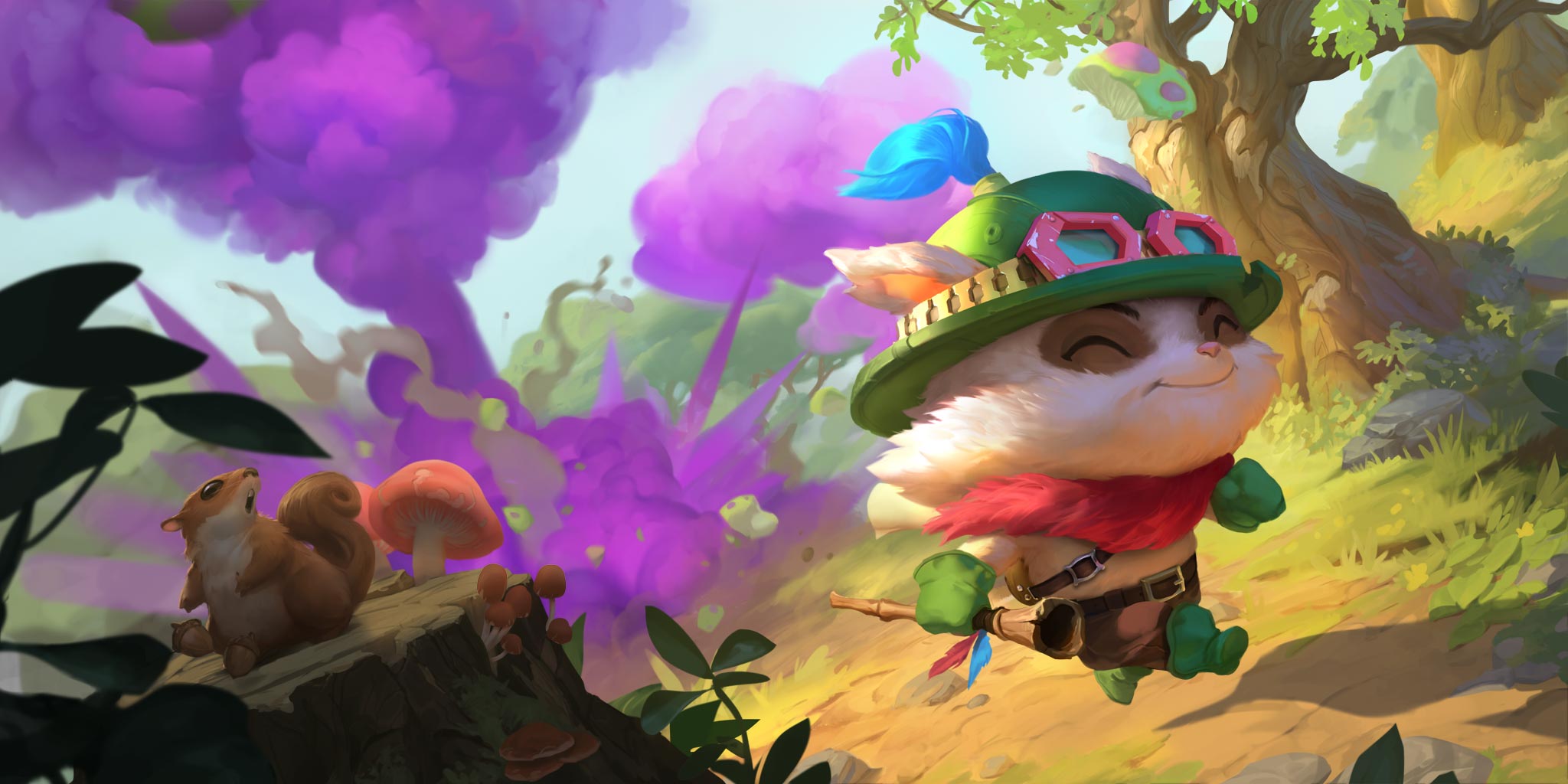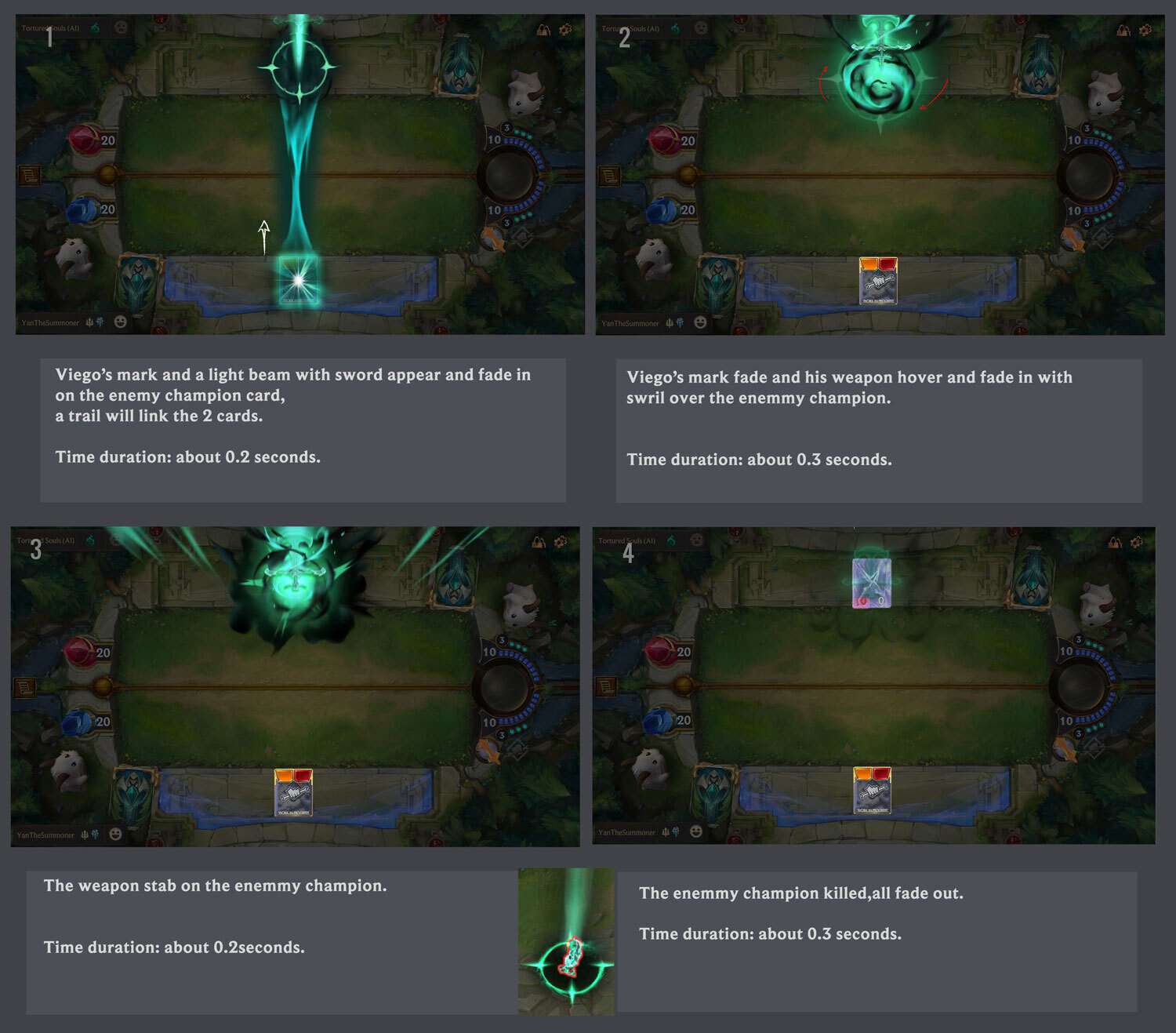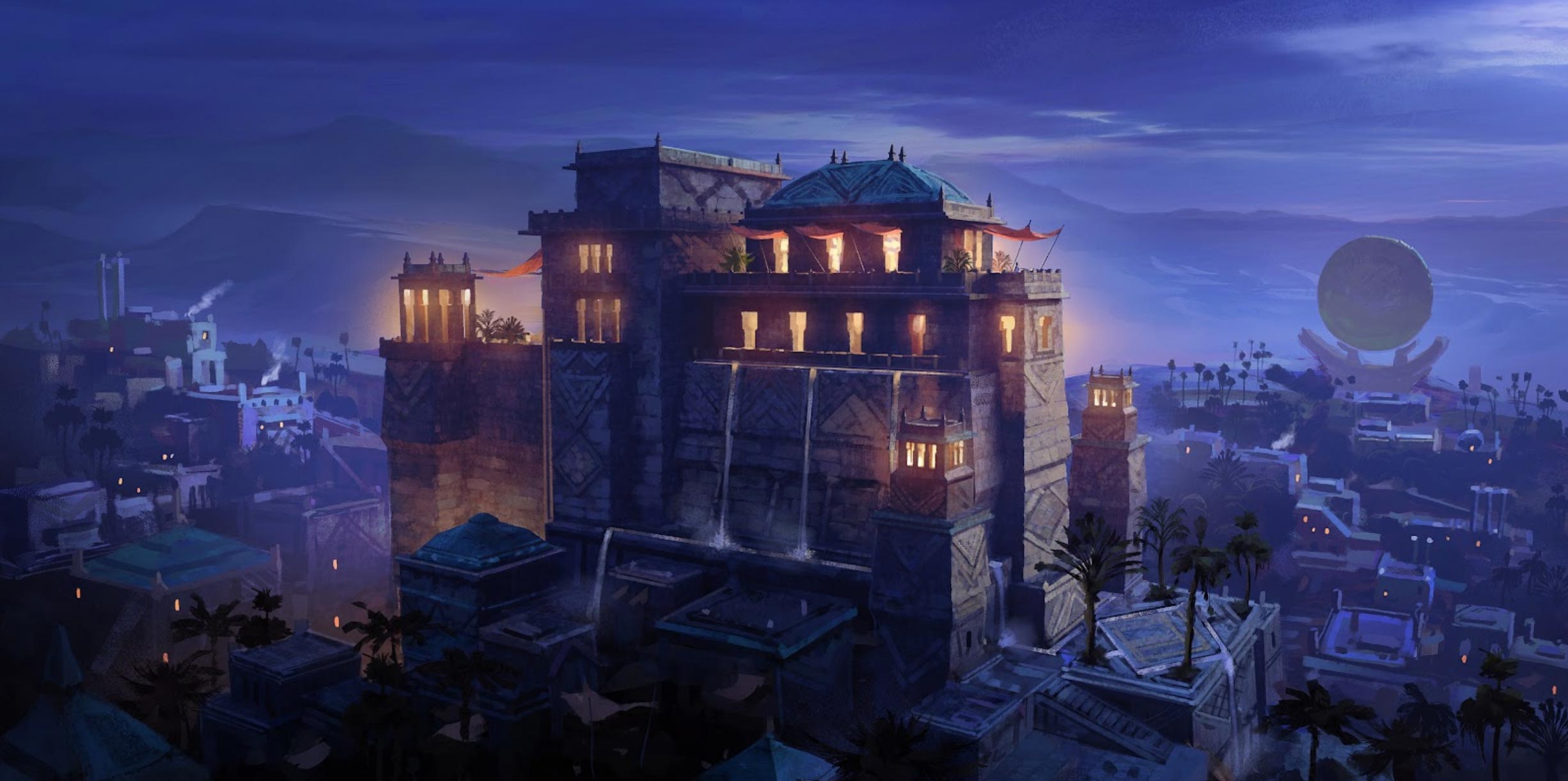Runeterran Truths
Legends of Runeterra expands on the previously unobserved world of Runeterra. We’re shaped by the foundation of League of Legends champions, but we take things a step further by developing the world that surrounds them. We want to give you a taste of what their lives are like, and the places and characters they interact with.
Our most pivotal endeavor is bringing existing champions to life in a way that feels true to their character. Champions in LoR are not simply 1:1 ports based on their kits in League. As a card game, we have separate needs and exploration spaces than our MOBA counterpart. But we also want to stay aligned with each champion’s Runeterran Truths. We aspire to recreate characters of Runeterra by representing them based on their most identifiable and beloved aspects, which make up what we call their “Champion Resonance”—how much a champion feels like themselves. To achieve these aspirations, Game Designers like myself work in tandem with our “DNA” team (designers, narrative writers, and artists).
With that comes new and exciting opportunities for champs to live their ultimate gameplay dreams, such as Teemo shuffling thousands of mushrooms into your deck. In LoR, Teemo is annoying, sneaky, puts mushroom traps EVERYWHERE and always abides by the scouts’ code! He is a bit fragile and has a camouflage-inspired keyword in Elusive. He doesn’t have his iconic Blinding Dart or Toxic Shot, but he’s still quite recognizable and feels like the Teemo that everyone knows.
We want Champions to look, feel and act the way players know they should. What makes Teemo… Teemo across products are what we consider his Runeterran Truths. These truths manifest both through his lore and gameplay, but also through the emotions and fandom of how our players experience them in our games. Then, we like to go even further whenever possible, and explore unique LoR mechanics that add onto a champion’s legacy.
Champion Design: Mechanics vs. Thematics
When recreating champions in another game, game designers must determine what parts of them will be the most iconic. Personally, I like to begin by figuring out whether their champion resonance is based more on their Character Thematics or their Gameplay Mechanics. Thematics are the themes, ideas, and story that define them. Mechanics are the abilities and playstyle they have in League.
To do this, we use data compiled from League players that provide key insights on popularity, thematic scores, gameplay mechanics, visual appeal, and more!
For example, while working on the design team for the Mount Targon Expansions (led by Shawn “Eyebrow Poro” Main), we knew we needed to include everyone’s favorite space dragon, Aurelion Sol! During development, our research indicated that Aurelion Sol players identified more with his thematic than his gameplay. A celestial dragon who can shift the cosmos and forge stars was more compelling than the specifics of his abilities in League.
Shawn dove heavily into ASol’s power fantasy, reimagining his abilities to match his otherworldly capabilities.This included the outlandish creation of a 22-card mini-set cycle of superpowered Celestial cards, giving him SpellShield, and a huge 10|10 stateline to reinforce his capabilities.
Players absolutely loved it, and he was one the our most successful champions ever made. League is even giving Aurelion Sol a thematic-focused core gameplay update this year!
Bringing Nasus to LoR for the Empires of the Ascendent expansion (led by Mark “G-Major” Sassenrath) was a bit of a different story. This time, we found ourselves with a champion whose identity revolved around his gameplay mechanics.
For each champion we ask players: “In your opinion, what characteristics do you think best define them?” We scrub the data and create a word cloud with top responses. For Nasus, nearly all of the feedback was centered around his Siphoning Strike, farming, and stacking. Take a look!
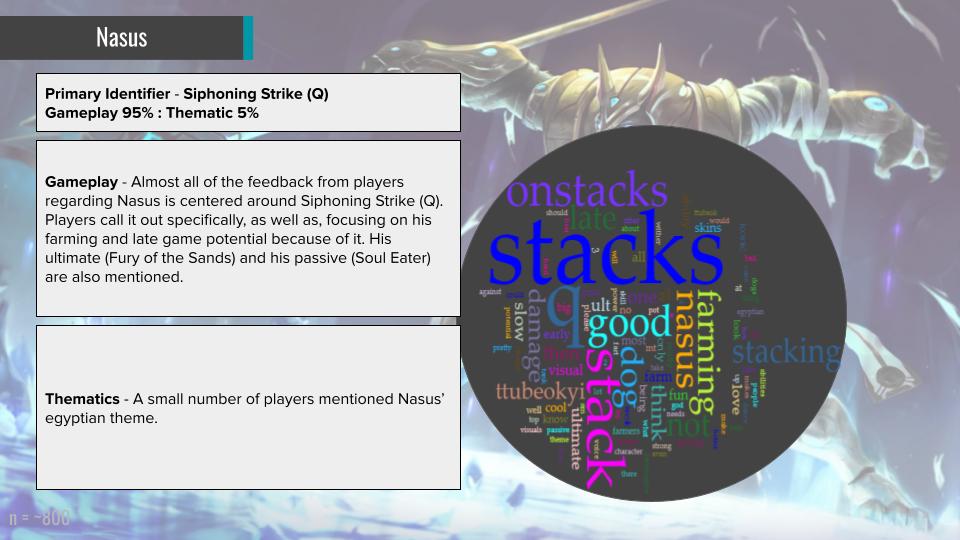
It was clear that in order to nail Nasus’ resonance we needed to hone in on his stacking mechanic. We ended up developing the Slay mechanic and supporting cards, which was a great fit to let you “stack” Nasus stats. We added in Siphoning Strike as a champion spell to incorporate even more stacking and bonking!
Going beyond champ resonance, LoR champs that truly shine also add texture to their Regions, enabling new archetypes, possibilities, and playstyles. Since he was being introduced with Shurima, Nasus had a sizable opportunity to go beyond just being a stacking doggo, but helping establish Shurima’s identity and create interesting and useful tools for it through his design. We stayed core to his Runeterran Truths and player expectations, with the added spice of being among the first Champs to level up multiple times.
Nasus is a relatively simple champion who delivered hard on his expected fantasy and, much like ASol, was able to propel Runeterra to new, interesting Regions.
Forging a Path: Creating Champions From Scratch
One of the newer challenges LoR has faced as we chew through the existing roster of champions in Runeterra is designing champions that are either unreleased or newly released in League.
These champs don’t quite have their designs and narrative stories locked. We don’t know exactly what specific parts of them will resonate with players yet. We could guess what some of their Runeterran Truths would be, but they won’t be reinforced yet by players.
I had the pleasure of taking on this challenge for the first time as the lead designer of the Ruined King Event & Champion Expansion. This was a small expansion with two champions—Viego and Akshan—and out of the gate I had a goal to experiment with broad designs that would make the most of a small amount of cards allotted to the release. This would allow players to discover and experiment with many possibilities, instead of defaulting to popular combinations of champions such as Maokai and Nautilus.
Viego and Akshan were both unreleased League champions during their development for LoR, and for the first time ever, LoR released a champ—Akshan—at the same time as League!
This meant we had more of an opportunity to focus on developing mechanics without the normal constraints of Runeterran Truths, Champion Resonance, and Thematic vs Mechanical based design. When developing Viego and Akshan, we needed to use a bit more of an out of the box approach since the character hasn’t quite found their footing in the world of Runeterra. Operation take what we have, and try some cool things to the game that could fit was in effect!
We collaborated as closely as we could with League to follow their evolving League of Legends abilities and kits, taking major gameplay and thematic pillars that seemed like they were unlikely to change.
For gameplay mechanics, we mainly hone in on what we anticipated would be a champion’s gameplay hook once released in League. What part of the kit will be the special sauce that makes a champion people love to love and love to hate?
Viego and the Black Mist
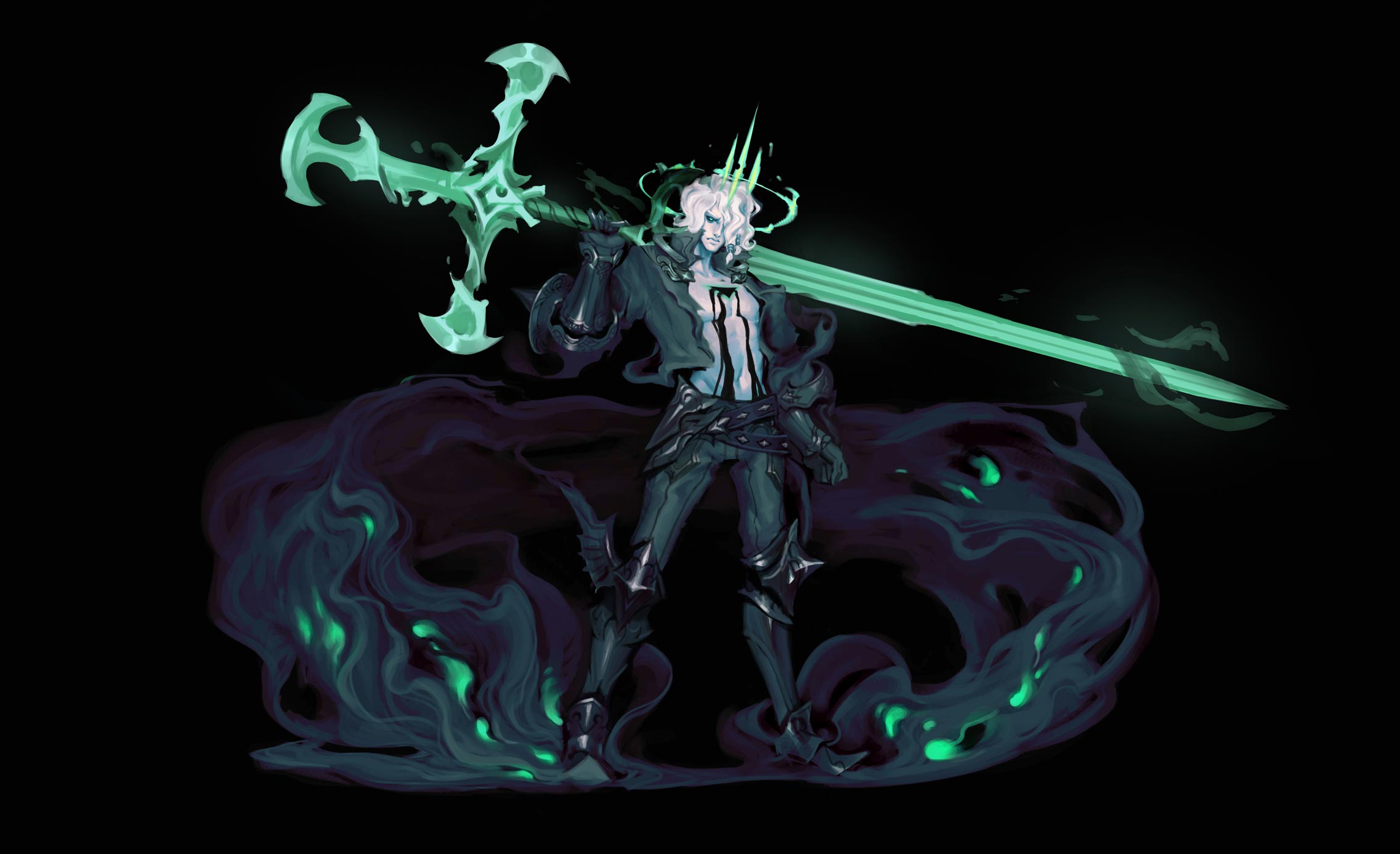
Viego’s gameplay hook was his ability to possess other champions and steal their abilities. This proved quite tricky, since under no circumstances do we allow you to control your opponents’ champions in LoR. With this in mind, our main focus became capturing both his black mist and the idea of him as the all powerful Ruined King.
So, it was time for some initial design work! This is the early phase of design, where we spend time in highly collaborative brainstorms to generate ideas. The best (or craziest) ideas move into paper playtests, where we play physical LoR with sharpied cards (or our fancy LoR spreadsheet)! The focus here is to learn, validating new mechanics and potential patterns so that the next iteration can make improvements or even take entirely different directions based on what we learn.
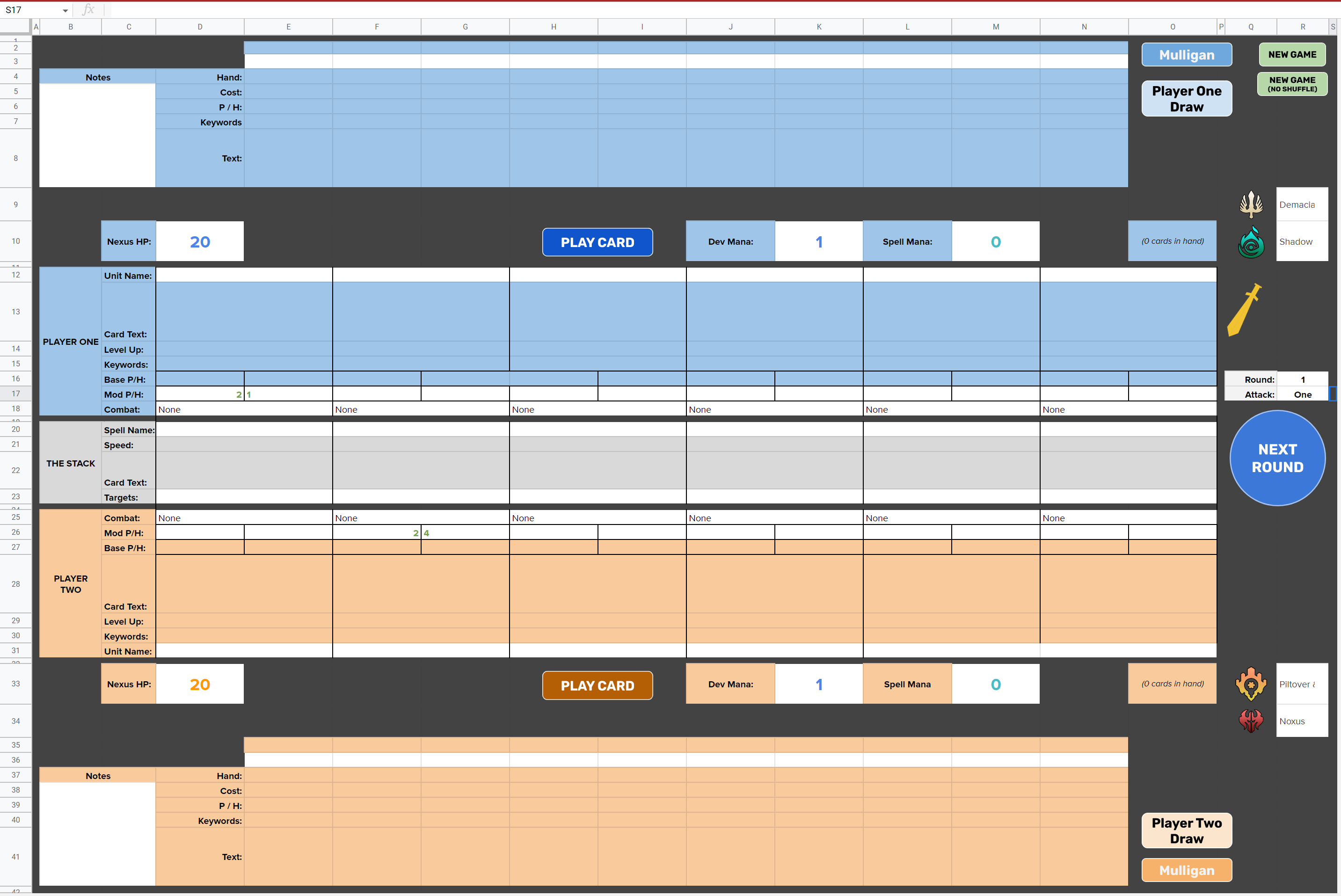
For Viego, one of my crazier ideas leaned heavily into his gameplay hook around possessing Champions, which I recreated in LoR with an ability that stole enemy champion spells. Viego and his followers let you manifest the Champion Spells based on the champions your opponent was playing. Some of them even synergized with playing Champion Spells.
I took it even further, and created an archetype which I named “Champion Spell Revival.” It was fascinating that stealing Champ Spells resulted in creating copies of those champs in your deck. So Viego and his followers would let you “steal” opposing champs by creating, then drawing or summoning them for your deck:

Viego Test Follower A
2c 1|1
[Play]: Manifest one of your opponent’s Champion Spells.
Viego Test Follower B
3c 3|3 [Fearsome]
When you play a Champion Spell, grant me +1|+1.
Viego Test Follower C
4c 4|3
When I’m summoned, if you have a Champion in your deck that didn’t start there, draw it.
Viego Test
6c 5|6 [Fearsome]
Play: Manifest one of your opponents Champion Spells.
Attack: Summon a Champion from deck Attacking that didn’t begin the game in your deck.

After these playtests, it was evident that Viego wanted to be more of the star of the show, and that using players’ Champions against them was not a great experience.
This is a great example of how we often go through several different versions of champions during initial design. Testing out rough versions of champions early in the process really helps us iterate towards directions that work and really find the fun! Each iteration can teach us something.
I directed our focus more on Viego being an all-powerful entity with more traditional Shadow Isles mechanics. Ephemeral Encroaching Mist fit well in Shadow Isles and hit the scaling power fantasy of being the Ruined King. I really loved the idea of a Level Up Quest that would have you heartlessly sacrificing your own allies to gain power. As a way of tying in possession from League, I ended up allowing Viego to steal followers as his end game moment on Level 2, but upgrading this into a straight up Champion kill if their strongest unit was a champ. Combined with his Level 2 upgrading to creating mists off of enemy deaths, hitting a champion now felt like a bonus powerful moment, even if you didn’t get to control them.
Akshan and the Vekauran Vipers
Akshan had a smoother development phase with fewer iterations than Viego, which was surprising given he was unfinished in League at the time. Similar to Viego, we took what we knew about him by collaborating with League, but there were still many unknowns.
His intended gameplay hook was clear: The ability to resurrect slain allies with his death-defying reverse murder gun, The Absolver. Thematically, we focused on his roguish charm, arrogant nature, and hunt to reclaim lost Sentinel weapons.
Many of our designs for Akshan took us down more thematically-driven and top-down design approaches.
One thing that interested me during initial design was the idea of Akshan as a lone wolf. It was a clear part of his theme as the Rogue Sentinel. Naturally, one of my early experiments was to design a new archetype around attacking “alone”—or with only one unit—and a new mechanic: Foray!
[Foray]: Gain the Attack token, only 1 unit may attack.

Akshan, Lone Wolf
2c 2|2
When I attack, give me [Elusive] this round.
Nexus Strike: At the next Round Start, [Foray].
Akshan Follower A
2c 2|2 [Fearsome]
When an ally attacks alone, give enemies -1|-0 this round.
Akshan Follower B
4c 3|4
When I’m summoned, create a {Lucky Find} and [Foray].
Akshan Follower D (Noxus)
1c 1|2
When an ally attacks alone, grant it +1|+0.
Akshan Follower E (Noxus)
3c 3|2
[Play]: An ally starts a free attack and give it Quick Attack this round.
You can actually see an early version of Ruined Reckoner in this last follower! Sometimes we interweave multiple archetypes experiments at once. When we learn what works and what doesn’t work, we often cherry-pick some of the good designs for future adaptations!


The Lone Wolf/Solo Attacker deck was a workable, resonant concept. But the gameplay didn’t quite work out—it got repetitive and you quickly reached points in the game where you would want to attack with multiple units anyway. The concept was scrapped.
Then, Akshan’s co-designer David “Plinq” Smith had a great idea around what he called “The Dungeon of Doom”. Which was a long countdown landmark Akshan created that unlocked sick loot with a few ways to advance it. This was very Indiana Jones vs. the vast Shuriman desert, another thematic-focused design that was heavily inspired by ideas around adventure and exploration.
Thematically, the loot was a workable fit to represent Akshan’s hunt for Relic Weapons. Mechanically, however, it didn’t feel quite right. While Countdown Landmarks were very Shuriman, it was old news and didn’t feel very specific to Akshan. It wasn’t adding anything to Shurima, which didn’t quite cut it for a new champ.
The breakthrough we needed came with an idea to advance the landmark faster through targeting allies. This really brought the deck to life, since it required proactivity, precision, and planning. It also added a fun new angle to Shurima’s toolkit.
This gave us a lot of confidence in extending Akshan’s mechanics to his supporting cast of Vekauran Vipers. Akshan and Vekauran Vagabond added targeting matters, and we introduced new ways to get Lucky Finds through Vekauran Bruiser. Finally, we added in some synergistic and resonant spells—Grappling Hook and The Absolver—that solidified the self-targeting play pattern that we knew could potentially become iconic parts of Akshan’s kit.

Akshan and Viego led to some meaningful revelations about different ways of making champions for LoR. Delivering thematic or mechanical adaptations are still important, but not always explicitly required to create highly resonant characters. Having the freedom to delve into exploratory early design that could work and can fit, can create opportunities for superb designs.
From adhering to Runeterran Truths, to hitting Champion Resonance, each champion has its own path to make it to LoR. Flexibility in design is ultimately what will allow us to continue to make champions and archetypes for new card sets. Sometimes you have a Nasus, or Aurelion Sol, or Viego—each time you need to do something a bit differently to deliver designs that create remarkable gameplay experiences.
Thanks for reading! I hope this article shed some light on the process of creating LoR champions and shared some fun behind-the-scenes stories!

